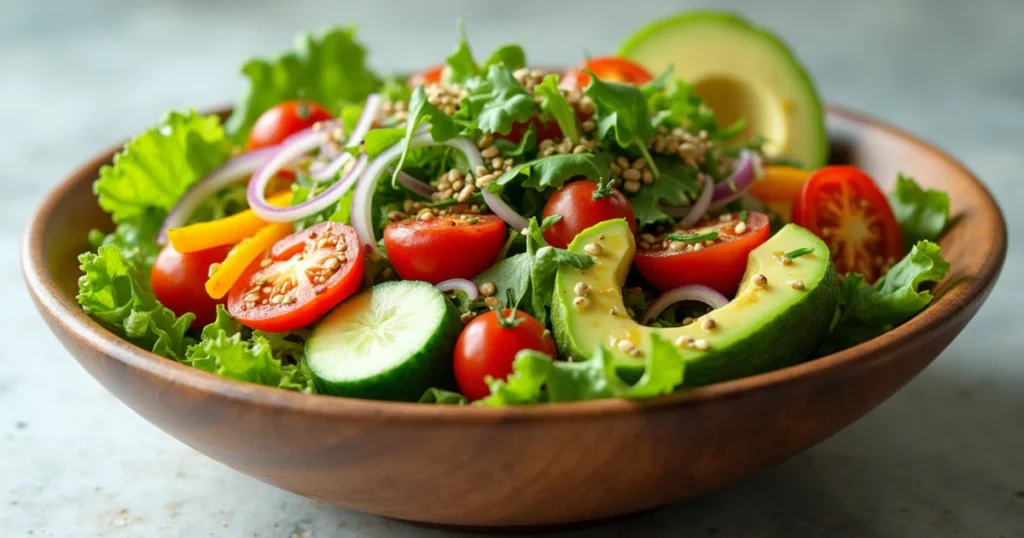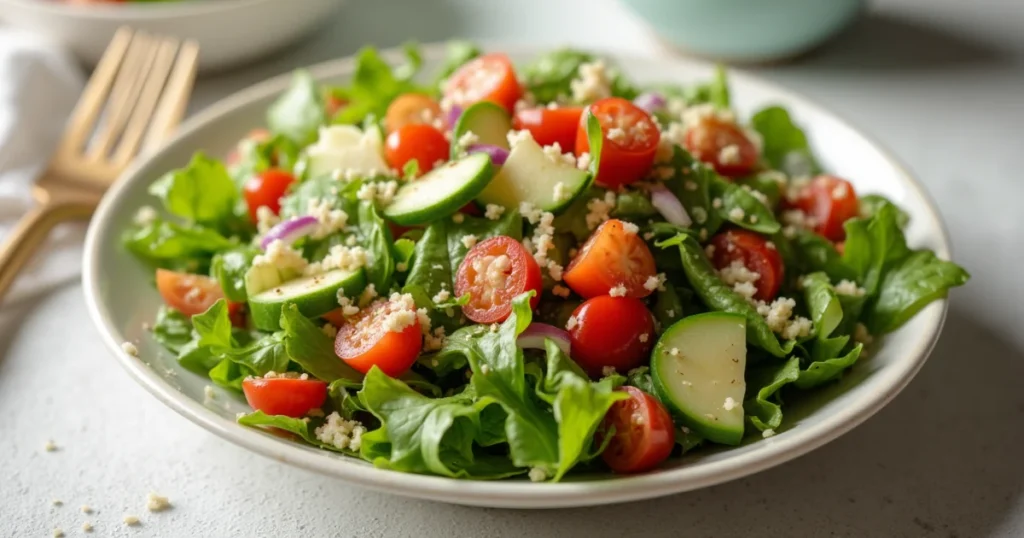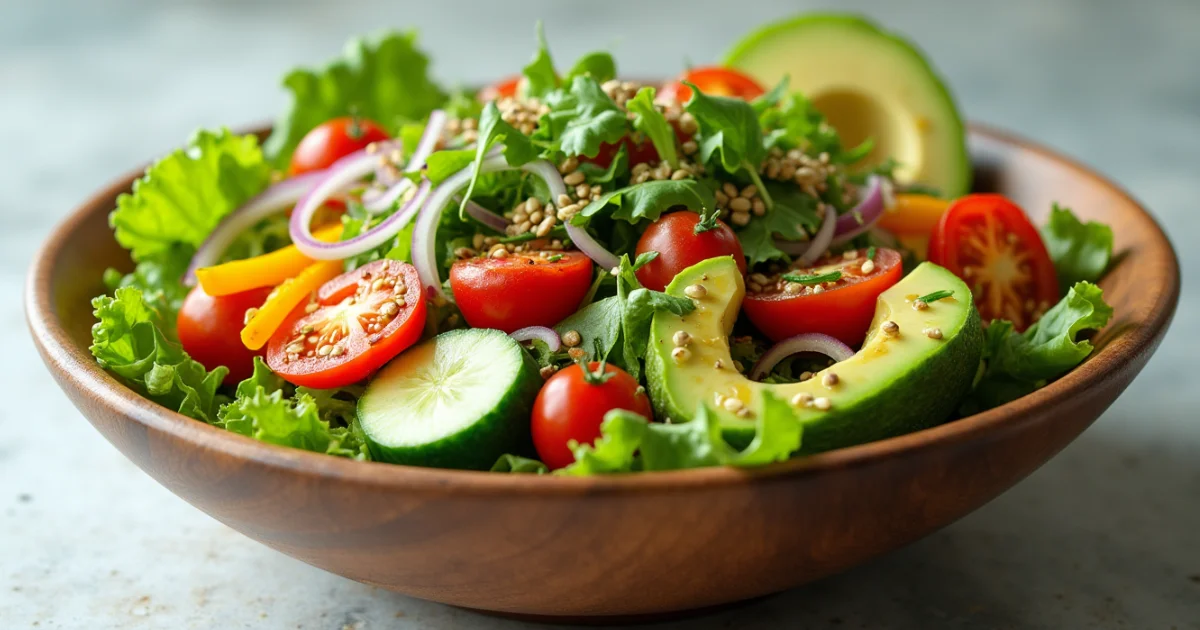Healthy Salad Ideas for a Nutritious Lunch
There was a time when salads felt like a punishment—bland greens drowned in creamy dressing. But what if I told you salads could be the star of your meal? This guide is for anyone craving nutritious salad recipes that satisfy both hunger and taste buds. Imagine vibrant bowls packed with protein, healthy fats, and bold flavors—meals so satisfying, you’ll forget they’re good for you.
Healthy salad ideas don’t have to mean sacrificing flavor. Whether you’re meal prepping for the week or hosting a dinner, these recipes blend science-backed nutrition with creativity. Discover how simple swaps—like swapping iceberg for nutrient-rich kale or arugula—can turn a basic salad into a powerhouse of vitamins, fiber, and antioxidants. Without having to guess, every mouthful becomes a step towards eating a balanced diet.

Table of Contents
The Power of Nutritious Salad Recipes in Your Diet
Nutritious salad recipes are more than just a quick lunch—they’re a cornerstone of balanced nutrition. By prioritizing fresh ingredients, these dishes deliver essential vitamins, fiber, and antioxidants missing in many processed foods. Here’s why they belong at the heart of your meal planning.
Why Salads Are Essential for Balanced Nutrition
Lentils and spinach are good sources of iron and calcium. Add bell peppers or carrots for vitamin C, and nuts or seeds for healthy fats. Antioxidants in vibrant vegetables fight cellular damage, while the fiber in salads helps maintain consistent energy by delaying the absorption of sugar.
- Spinach: 2g fiber per cup (USDA)
- Broccoli: 3g fiber per serving
- Avocado: 10g fiber per fruit
Health Benefits of Regular Salad Consumption
Research highlights how salads improve health across multiple systems. Here’s how they make a difference:
| Benefit | Nutrient Link | Study Insight |
|---|---|---|
| Improved Digestion | Fiber content | Harvard T.H. Chan School of Public Health says that veggies can cut your risk of constipation by 20%. |
| Heart Health | Antioxidants | The American Heart Association reports 15% lower LDL cholesterol in salad eaters. |
| Weight Management | Low calorie density | Salad eaters dropped 185 calories daily in 2023–2024. |
Breaking the “Boring Salad” Stereotype
Healthy salad ideas go beyond lettuce and dressing. Crisp apples, creamy avocado, or crunchy chickpeas are examples of textural contrasts that might inspire new salad ideas. Swap plain greens for kale or arugula, and experiment with global flavors like Thai peanut sauce or citrus-tahini blends. Add protein like grilled shrimp or chickpeas for staying power. The result? A meal that is both filling and healthy.
- Add smoky grilled veggies for depth
- Drizzle with balsamic glaze or miso dressing
- Top with toasted seeds or crumbled feta
Essential Equipment for Crafting Perfect Salads
Streamlining your kitchen setup can turn easy salad recipes into daily staples. The correct equipment ensures that quick salad lunches remain tasty and fresh by reducing prep time and improving ingredient quality. Start with a sharp chef’s knife—like the Wüsthof Classic Ikon—for clean cuts that preserve vegetable crispness. A sturdy cutting board, such as those from Chef’sChoice, prevents cross-contamination and protects surfaces.
A salad spinner (e.g., OXO Good Grips) dries greens efficiently, eliminating soggy leaves. For uniform veggie slices, a mandoline slicers like Benriner ensures consistent texture in every bite. Don’t overlook storage: airtight containers from Rubbermaid keep ingredients fresh, while herb keepers like HerbStop preserve parsley or cilantro for days.
| Tool | Purpose | Top Brands |
|---|---|---|
| Chef’s Knife | Cuts greens and veggies evenly | Wüsthof, Shun |
| Mandoline Slicer | Uniform slicing for consistent texture | Benriner, Swissmar |
| Salad Spinner | Dries greens for crisp salads | OXO, Joseph Joseph |
| Storage Containers | Keeps ingredients fresh | Rubbermaid, Pyrex |
Budget-friendly alternatives exist: a serrated knife works for basic cuts, and a clean towel can air-dry greens. Prioritize quality for high-use items like knives. Investing in these tools transforms salad prep into a seamless routine, making it simpler to experiment with easy salad recipes nightly.
Building Blocks of a Great Salad: Foundation Ingredients
Every great salad starts with foundational ingredients that set the stage for flavor and nutrition. Choosing the right base components ensures your salads are both satisfying and nutrient-rich, forming the backbone of nutritious salad recipes that keep meals exciting.
Leafy Greens and Their Unique Nutritional Profiles
Leafy greens are the unsung heroes of plant-based salads. Beyond iceberg, options like kale (iron-rich), spinach (packed with folate), peppery arugula, and crisp romaine offer distinct textures and nutrients. Mix varieties for balanced nutrition and flavor.
Cruciferous Vegetables for Added Crunch and Benefits
Cruciferous veggies like broccoli, cauliflower, and cabbage add satisfying crunch while delivering antioxidants. Roasting or massaging kale can soften bitter notes, making these cancer-fighting ingredients a must in hearty plant-based salads.
Colorful Vegetable Additions for Nutrient Variety
Building colorful salad bowls means including red peppers (vitamin C), orange carrots, and purple cabbage. The notion of “eating the rainbow” guarantees a variety of phytonutrients. Roasted butternut squash or shredded beets provide natural sweetness without the use of artificial sweeteners.
Fresh Herbs That Elevate Flavor Profiles
Fresh herbs like basil, cilantro, and dill transform simple salads into gourmet dishes. Store herbs in water or freeze chopped batches for year-round use. A sprinkle of mint in a cucumber salad or parsley in a grain bowl boosts freshness without extra calories.
Protein-Packed Additions for Satisfying Salads
Adding protein turns simple salads into hearty meals that keep you full. For plant-based salads, legumes like chickpeas or lentils deliver fiber and protein. Try Eden Foods organic black beans or Lightlife veggie crumbles for a meat-free boost. Tofu and tempeh add texture—marinate tempeh in soy sauce and garlic before tossing it into greens. Edamame or roasted chickpeas make quick toppings.
- Legumes: Canned chickpeas (drained) or cooked lentils add 15g protein per cup.
- Nuts/seeds: A handful of walnuts or hemp seeds provide healthy fats and protein.
- Tofu/tempeh: Firm tofu works well cubed in Asian-inspired delicious salad combinations.
Animal proteins like grilled chicken breast or smoked salmon elevate flavor. Hard-boiled eggs (use Eggland’s Best) or a few slices of deli turkey add quick protein. Vital Choice wild-caught salmon provides omega-3s. Shredded rotisserie chicken saves prep time.
- Chicken: Slice leftover roasted chicken for a 3-ounce portion.
- Fish: Canned mackerel or sardines add ocean-derived protein.
- Cheeses: Crumbled feta or goat cheese boost calcium alongside protein.
Pair proteins with acid-based dressings to balance flavors. Pre-cook proteins in bulk—grill extra chicken or boil eggs weekly. Mix textures: crumble feta over crispy chickpeas or top arugula with seared shrimp. Protein-rich salads keep hunger at bay, making them ideal for lunch or light dinners.
Smart Carbohydrate Choices for Energy-Balanced Bowls
Adding smart carbohydrates to salads transforms them into meals that fuel your day. Nutritious salad recipes thrive when they include complex carbs for steady energy—no more carb-free myths. These choices make easy salad recipes both satisfying and nourishing.
Whole Grains That Complement Salad Ingredients
Incorporate whole grains to boost fiber and flavor. Cook quinoa, farro, or brown rice until tender, then cool before mixing into greens. Here’s how to perfect your grain salads:
| Grain | Cooking Tip | Pairing Idea |
|---|---|---|
| Quinoa | Boil in broth for extra depth | Pair with citrus vinaigrettes and avocado |
| Farro | Rinse before cooking to remove bitterness | Combine with roasted veggies and Parmesan |
| Barley | Cook until chewy, not mushy | Match with dried fruits and toasted nuts |
Starchy Vegetables for Natural Sweetness
Roast or grill starchy vegetables for caramelized flavors. Try these methods:
- Sweet potatoes: Slice thinly and bake at 400°F (200°C) for 20 minutes
- Butternut squash: Toss with olive oil and rosemary before roasting
- Corn: Grill briefly to enhance natural sugars
Add these to salads for hearty, nutrient-dense layers in easy salad recipes.

Legumes for Combined Protein and Carbohydrate Benefits
Chickpeas and lentils provide protein and fibre. Use canned beans for convenience—just rinse and drain. Try these combinations:
Chickpeas: Mash into a tahini dressing or toss whole into Mediterranean bowls.Black beans: Mix with corn and cilantro for a zesty base.Lentils: Use green or brown varieties in winter salads with citrus and feta.
Pair these smart carbs with leafy greens and healthy fats for balanced meals. These healthy salads make every bite count.
Seasonal Approach to Creating Colorful Salad Bowls
Unlock fresh salad inspiration by aligning your ingredients with the seasons. Seasonal produce tastes better, travels fewer miles, and offers peak nutrition. These colorful salad bowls become a canvas for nature’s changing palette, whether you’re in New York or California. Here’s how to adapt your recipes for every time of year:
Spring Harvest Combinations
- Pair baby spinach with pea shoots, radishes, and snap peas.
- Top with asparagus, strawberries, or microgreens.
- Drizzle with lemon-tarragon dressing for brightness.
Summer Bounty Inspirations
- Layer heirloom tomatoes, corn, and cucumber.
- Add grilled peaches or nectarines for sweetness.
- Try a mint-lime dressing or balsamic glaze.
Fall Harvest Ingredients
- Incorporate roasted butternut squash, pears, and walnuts.
- Mix with kale or Brussels sprouts for texture.
- Use maple-Dijon or apple cider vinaigrette.
Winter Comfort Salad Options
- Blend citrus segments (oranges, grapefruit) with endive.
- Add roasted sweet potatoes or beets for warmth.
- Finish with pomegranate seeds and a warm tahini dressing.
| Season | Key Produce | Pro Tip |
|---|---|---|
| Spring | Asparagus, peas, arugula | Shop at local farmers’ markets for peak freshness. |
| Summer | Watermelon, avocado, heirloom tomatoes | Layer ingredients to prevent sogginess. |
| Fall | Kale, pomegranate, pecans | Rosé or apple cider vinegar adds depth. |
| Winter | Citrus, persimmons, roasted root veggies | Balance bitter greens with sweet elements. |
Healthy Fats to Complete Your Nutritious Salad Recipes
Healthy fats transform salads into satisfying, nutrient-packed meals. Contrary to outdated advice, fats like olive oil and avocado enhance flavor while aiding absorption of vitamins A, D, and E from vegetables. Properly chosen fats also create texture contrasts that make delicious salad combinations more appealing and filling.
- Plant-based oils: Extra virgin olive oil adds peppery notes, avocado oil shines at high heat, and walnut oil’s nutty flavor pairs well with leafy greens.
- Whole-food fats: Mash avocado onto greens for creaminess, sprinkle toasted sunflower seeds for crunch, or top with marinated artichokes for umami depth.
- Moderate additions: Shaved parmesan or a drizzle of tahini adds richness without excess calories. A single poached egg yolk delivers nutrients and velvety texture.
Balance is key—aim for 1-2 tablespoons of oil per serving and use nuts/seeds in ¼-cup portions. Emulsified dressings including oil and acid distribute fats evenly, preventing soggy leaves. Prioritizing these techniques ensures salads stay both nourishing and crave-worthy in every bite.
Homemade Salad Dressings That Enhance Rather Than Overwhelm
Perfecting homemade salad dressings transforms even the simplest delicious salad combinations into memorable meals. Start with foundational techniques that balance flavors without overpowering fresh ingredients.
- Creamy Alternatives: Swap mayo with Greek yogurt or mashed avocado. Blend with lime juice and garlic for a light cilantro-lime dressing, or mix tahini with lemon zest for a Mediterranean twist.
- Gourmet Flavors: Infuse oils with rosemary or chili flakes during slow heating. Whisk miso paste with rice vinegar and sesame oil for umami depth, or combine harissa paste with olive oil for North African flair.
Proper storage extends freshness: store dressings in glass jars with tight lids. Oil-based vinagars stay stable up to two weeks refrigerated. Shake well before use—separated dressings can be rescued by adding a splash of warm water while whisking.
Pair dressings thoughtfully: crisp green salads shine with citrus vinaigrettes, while grain-based bowls benefit from nutty tahini blends. Adjust seasoning to match ingredient intensity, ensuring every bite highlights nature’s flavors without artificial additives.
Time-Saving Techniques for Quick Salad Preparation
Busy schedules don’t have to derail your quick salad meals. Master these strategies to cut prep time without compromising flavor or nutrition:
- Shop smart: Buy pre-washed greens, pre-cut veggies, or bagged mixes. Brands like Earthbound Farm offer ready-to use ingredients, saving 10-15 minutes daily.
- Batch prep weekly: Wash and chop veggies in one session. Store in airtight containers (e.g., Glad Press’n Seal bags) for 3-4 days. Pre-cook proteins like grilled chicken or quinoa and refrigerate portions.
- Tool hacks: Use a OXO Good Grips mandoline slicers for uniform veggie cuts. Food processors chop nuts or grains in seconds for easy salad recipes.
- Layered mason jar meals: Assemble salads in jars—place dressing at the bottom, dense ingredients like beans or grains next, then greens on top. Shake and toss before eating for quick salad meals in under 2 minutes.
Organize your fridge with a salad zone: dedicate a shelf to prepped veggies, dressings, and proteins. Label containers with dates to track freshness. For family meals, plan 3-4 easy salad recipes weekly. Prep double portions of staples like roasted veggies on Sunday for multiple uses.
With these steps, even rushed days can include fresh salads. Prioritize convenience without sacrificing quality—your next quick salad meal starts with 10 minutes of Sunday prep and smart storage.
Conclusion: Transforming Your Meals With Delicious and Healthy Salads
Salads are more than just a diet staple—they’re a canvas for creativity and nourishment. By applying the principles outlined, you can turn simple greens into vibrant meals packed with flavor and nutrients. Healthy salad ideas like protein-rich bases and seasonal mixes prove that balanced eating doesn’t require sacrifice. Every ingredient choice, from crisp vegetables to homemade dressings, contributes to a meal that satisfies both body and palate.
Fresh salad inspiration awaits in every season. Whether building a hearty grain bowl or a light summer mix, these meals adapt to your lifestyle. Overcoming the myth of “boring” salads starts with exploring textures, flavors, and global flavors. Prioritizing whole foods reduces waste and supports sustainable eating, making every bowl a step toward healthier habits and a lighter footprint.
Begin by selecting one new technique or ingredient from this guide to try within the next week. Whether it’s a citrus-tahini dressing or a protein-packed grain blend, small changes add up. Share your creations online or with friends to fuel motivation. Let these recipes spark a lasting shift toward meals that are as enjoyable as they are nutritious. Your next plate is waiting—build it boldly, eat it joyfully.

